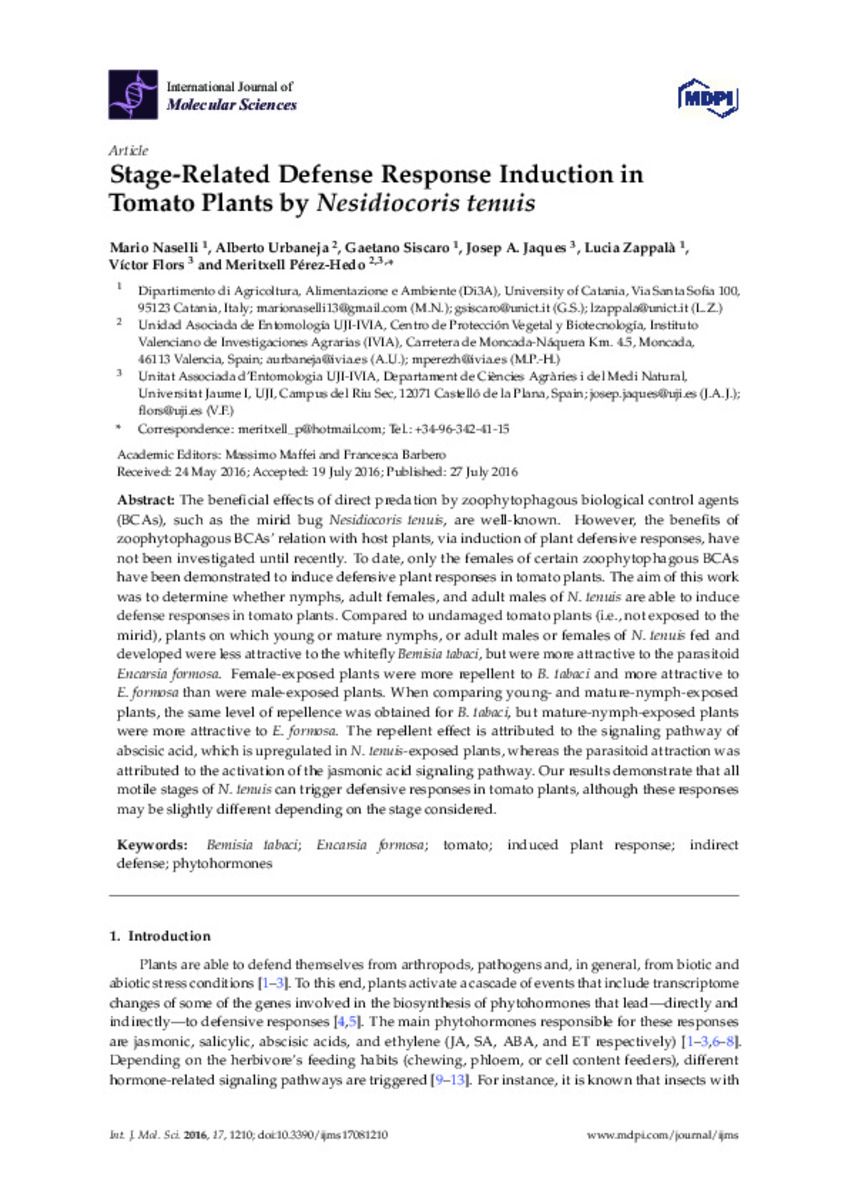Mostrar el registro sencillo del ítem
Stage-Related Defense Response Induction in Tomato Plants by Nesidiocoris tenuis
| dc.contributor.author | Naselli, Mario | |
| dc.contributor.author | Urbaneja, Alberto | |
| dc.contributor.author | Siscaro, Gaetano | |
| dc.contributor.author | Jaques , Josep A. | |
| dc.contributor.author | Zappalà, Lucia | |
| dc.contributor.author | Flors, Victor | |
| dc.contributor.author | Perez-Hedo, Meritxell | |
| dc.date.accessioned | 2016-10-17T09:23:37Z | |
| dc.date.available | 2016-10-17T09:23:37Z | |
| dc.date.issued | 2016-07-27 | |
| dc.identifier.citation | NASELLI, Mario; URBANEJA, Alberto; SISCARO, Gaetano; JAQUES MIRET, Josep Anton; ZAPPALÀ, Lucia; FLORS HERRERO, Víctor; PÉREZ HEDO, Meritxell. Stage-Related Defense Response Induction in Tomato Plants by Nesidiocoris tenuis. International Journal of Molecular Sciences (2016), v. 17 n. 8, pp. 1-13 | ca_CA |
| dc.identifier.uri | http://hdl.handle.net/10234/163616 | |
| dc.description.abstract | The beneficial effects of direct predation by zoophytophagous biological control agents (BCAs), such as the mirid bug Nesidiocoris tenuis , are well-known. However, the benefits of zoophytophagous BCAs’ relation with host plants, via induction of plant defensive responses, have not been investigated until recently. To date, only the females of certain zoophytophagous BCAs have been demonstrated to induce defensive plant responses in tomato plants. The aim of this work was to determine whether nymphs, adult females, and adult males of N. tenuis are able to induce defense responses in tomato plants. Compared to undamaged tomato plants (i.e., not exposed to the mirid), plants on which young or mature nymphs, or adult males or females of N. tenuis fed and developed were less attractive to the whitefly Bemisia tabaci , but were more attractive to the parasitoid Encarsia formosa . Female-exposed plants were more repellent to B. tabaci and more attractive to E. formosa than were male-exposed plants. When comparing young- and mature-nymph-exposed plants, the same level of repellence was obtained for B. tabaci , but mature-nymph-exposed plants were more attractive to E. formosa . The repellent effect is attributed to the signaling pathway of abscisic acid, which is upregulated in N. tenuis -exposed plants, whereas the parasitoid attraction was attributed to the activation of the jasmonic acid signaling pathway. Our results demonstrate that all motile stages of N. tenuis can trigger defensive responses in tomato plants, although these responses may be slightly different depending on the stage considered. | ca_CA |
| dc.description.sponsorShip | The research leading to these results was partially funded by the Spanish Ministry of Economy and Competitiveness (AGL2011-30538-C03 and AGL2014-55616-C3), the Conselleria d’Agricultura, Pesca i Alimentació de la Generalitat Valenciana, and the Italian Ministry of Education, University and Research (PRIN project 2010CXXHJE_004). The authors thank Javier Calvo (KOPPERT BS) for the supply of insects and Servei Central d’Instrumentació Científica of the Universitat Jaume I for technical support. MN received a PhD grant from the University of Catania (Italy). MP-H received a postdoctoral fellowship (Juan de la Cierva program) from the Spanish Ministry of Economy and Competitiveness. | ca_CA |
| dc.format.extent | 13 p. | ca_CA |
| dc.format.mimetype | application/pdf | ca_CA |
| dc.language.iso | eng | ca_CA |
| dc.publisher | MDPI | ca_CA |
| dc.relation.isPartOf | International Journal of Molecular Sciences (2016), v. 17 n. 8 | ca_CA |
| dc.rights.uri | http://rightsstatements.org/vocab/CNE/1.0/ | * |
| dc.subject | Bemisia tabaci | ca_CA |
| dc.subject | Encarsia formosa | ca_CA |
| dc.subject | Tomato | ca_CA |
| dc.subject | Induced plant response | ca_CA |
| dc.subject | Indirect defense | ca_CA |
| dc.subject | Phytohormones | ca_CA |
| dc.title | Stage-Related Defense Response Induction in Tomato Plants by Nesidiocoris tenuis | ca_CA |
| dc.type | info:eu-repo/semantics/article | ca_CA |
| dc.identifier.doi | http://dx.doi.org/10.3390/ijms17081210 | |
| dc.rights.accessRights | info:eu-repo/semantics/openAccess | ca_CA |
| dc.relation.publisherVersion | https://www.ncbi.nlm.nih.gov/pmc/articles/PMC5000608/ | ca_CA |
Ficheros en el ítem
Este ítem aparece en la(s) siguiente(s) colección(ones)
-
CAMN_Articles [566]







